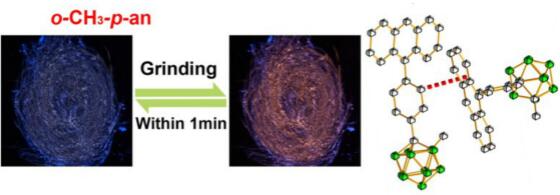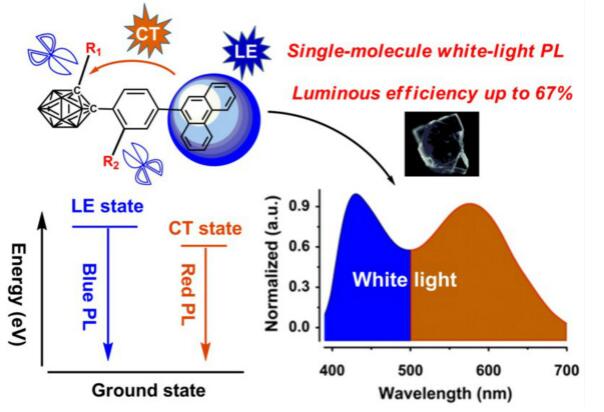Icosahedral carboranes are classified into ortho, meta and para-borane based on the spatial position of two carbon atoms due to their three-dimensional sterically hindered geometry and push-pull electronic properties and high thermal and chemical stability. Sex can be used as a building block to synthesize various luminescent functional molecules. Studies have found that ortho-carbon borane can induce charge transfer emission as a strong electron acceptor. How to construct novel carborane materials using the characteristics of carborane is worthy of further study.
The Yanhong team first focused on force-chromic materials, and its response to external forces could be used in pressure sensing and optical information storage. Typically this property is used in non-volatile memories, however strong intermolecular interactions in the solid state make volatile memories difficult to implement. The research group introduced a carboboran group into a luminescent group to form a "DpA" configuration luminescent molecule, and realized such a self-repairing force-changing material (Chem. Commun. DOI: 10.1039/c6cc07093k). It was found that the presence of carborane allows the compound to achieve a force-chromic response by force-regulating the charge transfer in the solid-state molecule. The response can also be restored to its original state in 1 minute (Fig. 1), with the need for volatile memory. The performance shows potential application prospects.
Â

Figure 1. Carborane self-repairing force-changing material
Â
Inspired by the multiple emission characteristics of the above carborane compounds in the solid state, the group believes that through reasonable design, it should be possible to achieve white light emission in the solid state of such single organic compounds! The white light devices currently used for illumination and display are mainly realized by complementary colors or three primary colors, but suffer from problems such as difficulty in color repeatability and complicated preparation processes. In addition, due to the difficulty in precisely regulating the excited state of the molecule, in addition, the solid-state molecules usually exhibit aggregation quenching effects, and the broad emission spectrum, high-efficiency organic single-molecule white light materials are rarely reported. In response to this scientific problem, Yan Hong's group achieved solid-state white light emission by optimizing the donor unit in a simple preparation of carborax phenanthrene molecules with high thermal stability (decomposition temperature 360 ​​oC) (Fig. 2). Molecular structure tailoring makes the crystal structure of the compound change from H-aggregate to J-aggregate and cross-stack, and the absolute quantum efficiency of white light can reach 67%, which is the highest value of single-molecule organic white light materials. The research results are published in Angew. Chem. Int. Ed. DOI: 10.1002/anie.201703862.
The first author of the above research work was Tu Deshuang, a doctoral student at Nanjing University. He was co-founded by Associate Professor Lu Changsheng of Nanjing University and Professor Zhao Qiang of Nanjing University of Posts and Telecommunications, and was funded by the National Natural Science Foundation of China and the Ministry of Science and Technology-National Major Scientific Research Program.

Figure 2. Carborane monomolecular organic white light material
Â
Intern Editor: Yang Zhiwei
Other household electric appliance
gree , https://www.greegroups.com
